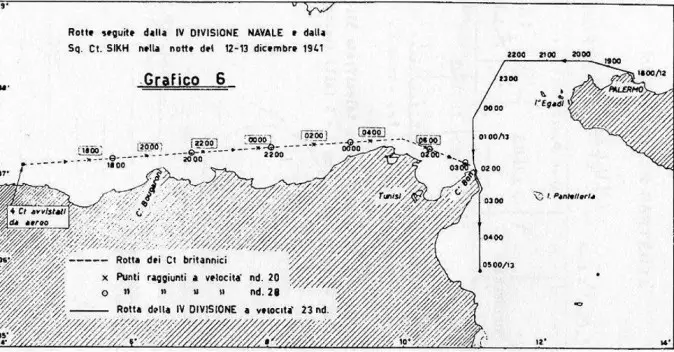The brief clash of Cape Bon caused the loss of two cruisers transporting vital fuel supplies for the Axis forces in North Africa. Another victory earned by the British thanks to ULTRA
Context
November 1941 can be defined as the “black month” for the Axis convoys directed to North Africa. During this month, the renewed allied air, naval and underwater offensive badly hit the axis supply lines as never before. In that month, only 30% of equipment safely arrived in the Libyan ports. In comparison, the average of the June-November period was 77% of equipment delivered, 87% for the personnel, and 69% for fuel supplies. On the 18th of November, the Commonwealth forces in North Africa launched their offensive against the Panzerarmee Afrika. Very soon, Rommel and General Ettore Bastico urged the Italian Supreme command to send in more reinforcements and supplies. In this critical context, the Regia Marina started to rely also on warships to carry out transport duties. This was the case for the IV cruiser division, consisting of the light cruisers Alberico da Barbiano, Alberto di Giussano, and Giovanni dale Bande Nere, the three ships all belonged to the Giussano class cruisers.
A false start
A first mission was scheduled for the 9th of December, the Barbiano and Di Giussano were loaded with some hundred tons of fuel supplies and left Palermo. However, when trespassed the northwest corner of Sicily, they were spotted by a British reconnaissance aircraft. The mission success strictly relied on full secrecy, since the ships were packed with highly inflammable cargo (partly loaded on the deck in the stern section) and could easily fell prey to any attack. Admiral Antonio Toscano, in command of the division, opted to abort the mission and returned to Palermo. His decision enraged the Navy and Army high command, so a new mission was scheduled for the 12th of December. This time, also the Bande Nere was meant to take part in the transport mission. However, an engine failure forced the ship to stay in port, leaving the two other ships to embark Bande Nere’s cargo. The Barbiano and di Giussano loaded in total 100 tons of aviation fuel, 250 tons of gasoline, 600 tons of naphtha, 900 tons of food.
ULTRA strikes again
On the 12th of December, some hours before the scheduled departure of the IV division, Italian reconnaissance aircraft based in Sardinia sighted four enemy destroyers 60 miles east of Algiers, steaming eastwards at 20 knots. These ships were, correctly, identified as ships transferring from Gibraltar to Alexandria. They were, in fact, the 4th Destroyer flotilla, consisting of the DDs Sikh, Maori, Legion, and Isac Sweers (dutch), transferring to the Mediterranean fleet in Alexandria. Contact was maintained for some hours and the allied ships maintained their speed. Supermarina (the Italian Navy high command) evaluated that these ships could not constitute a threat for Toscano’s cruiser, because:
- At their present speed, they would have never encountered the Italian cruisers
- Even by increasing their speed to 28 knots still, they would have missed the IV division
- With no sightings of the Italian cruisers (hid in the darkness), the enemy flotilla would have had no reason to increase their speed so much during a transfer voyage.
However, the British were well aware of the imminent departure of the IV division, thanks to ULTRA decryptions. As soon as the Italian reconnaissance aircraft disappeared, the 4th flotilla increased its speed to 30 knots. At this speed, they managed to arrive near Cape Bon, slightly before the IV division, and prepare their ambush.
The Italian cruiser left Palermo at 18:10, accompanied by the torpedo boat Cigno, and steamed towards the Tunisian coast, to descend then towards Cape Bon and the Kerkennah Islands. Around 2:45 AM, a British reconnaissance aircraft, equipped with radar, flew over the Italian formation. The aircraft could now guide the 4th flotilla against the unaware Italians.

The last image of the two cruisers in Palermo
Epilogue at Cape Bon
Around 3:25 AM, the 4th flotilla attacked the IV division, firing their artillery and launching a barrage of a torpedo from only 1000 meters. Three of them, in succession, hit the Alberico da Barbiano, (Toscano’s flagship), the hundreds of fuel gallons stored onboard soon ignited, enveloping the ship in a storm of fire, while the decks were crippled by artillery and machine gunfire. Badly hit, the crippled cruiser quickly capsized and sank while the leaked fuel continued to burn above the water.

A map showing the courses of the two opposing forces
Some torpedo also hit the Giussano, the ship however managed to fire a few shots with its 152mm forward turrets before listing heavily and breaking up into two parts. By 4:20, both ships had disappeared below the water, together with Admiral Toscano and 920 men. The torpedo boat Cigno escaped the massacre and later in the morning managed to rescue around 500 men from the cold waters. Other 150 men successfully reached the Tunisian coast and were rescued by Vichy French authorities.
Sources
Colombo, L. (2015). Alberico da Barbiano. Tratto da Con la pelle appesa a un chiodo : http://conlapelleappesaaunchiodo.blogspot.com/2015/02/alberico-da-barbiano.html
Giorgernini, G. (2001). La Guerra Italiana sul mare, La marina tra vittoria e sconfitta 1940-1943.
